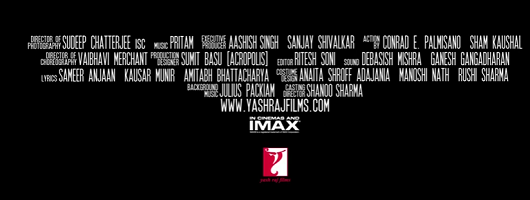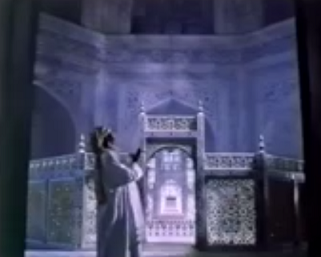IMAX in India
This is a collection of articles archived for the excellence of their content. |
Contents |
IMAX films
IMAX, a Canadian product, began as a very-big screen format for screening promotional, industrial and commercial films at trade fairs.
The first IMAX film was a 17 minute promotional film called Tora no ko (Tiger Child/ Japanese language/ 1970) directed by Donald Brittain (of Canada). It was made for Expo '70, which was held in Osaka, Japan.
IMAX films (like many Cinerama films) continued to be projected on temporarily erected screens at trade fairs till, in 1986, the first permanent IMAX 3D cinema was built in Vancouver, British Columbia. Even this auditorium was created for a trade fair: Expo '86.
One of the first ‘entertaining’ film in IMAX was the 85-minute rockumentary The Rolling Stones: Live at the Max (1991), which encapsulated the band’s Steel Wheels tour of the previous year. A number of entertaining documentary films in IMAX meant for general audiences, many of them rooted in space travel or the interesting aspects of science, followed.
Cineastes woke up to the potential of IMAX with the screening of the riveting documentary Everest (1998/ 70mm-IMAX/ USA/ 45 minutes), which had stunning, almost-mountain sized (all right, hillock-sized) images of the world’s tallest mountain, many of them shot from angles never seen before.
By the late-1990s IMAX auditoria had started springing up even in middle- income countries and regions like China, Thailand and Eastern Europe.
South Asia remained untouched, because of low incomes.
Jean-Jacques Annaud’s Wings of Courage (France/ 3D/ 1995/ 40 minutes) was the first ‘dramatic picture’ shot for IMAX. The Oscar winning The Old Man and the Sea (1999/ Canada, Japan, Russia/ dir. Aleksandr Petrov), based on Hemingway’s classic, was a 20 minute animated film.
Fantasia 2000 (prod: Disney/ USA/ 2000/ 75 minutes) was the first full-length animated feature meant, initially, for IMAX alone.
The first full-length feature films released in IMAX were Apollo 13 (September 2002) and Star Wars Episode II: Attack of the Clones (November 2002). Both were IMAX DMR (Digital Media Remastering) films.
All ‘IMAX feature films’ released in 2002 and thereafter were entirely or substantially shot in other formats and then remastered digitally. Only a few exceptions were partially shot in IMAX. (Most 70mm films were shot in 35mm and then blown up to 70mm.)
It was as late as in May 2015 that the first feature film to be shot entirely in IMAX was announced. This was the two-part film, Avengers: Infinity War. A modified version of Arri's Alexa 65 digital camera is being used for the photography.
IMAX cinemas in South Asia
Imax.com, the official website of IMAX, lists IMAX theatres around the world. In South Asia only India and Pakistan have been listed.
IMAX cinemas in India
History
IMAX came to India through the same route of scientific and commercial films.
India was to get its first Imax dome theatre in 2000 (Rediff.com). Manmohan Shetty, the owner of Adlabs, one of the country's leading film processing companies, was the promoter of the IMAX dome theatre in India. The 520 seat Adlabs IMAX in Wadala, Mumbai opened in 2001, a few months behind schedule. It was not only India’s first IMAX theatre, in its time it claimed to have the world's largest screen. In 2001, as would have been seen above, but for perhaps four or five films with a story (and even those were short films) IMAX essentially meant interesting documentary films and shorts.
Rohit Khilnani of moneycontrol.com would reminisce six years later, ‘The dome had a mammoth screen, exellent picture quality, multi- speaker sound and the overall Imax experience attracted a lot of people in its first year…[It] hosted some of the biggest premieres and parties.’
IMAX 3D, in Ahmedabad’s Gujarat Science City, which opened in 2002, was India’s second IMAX theatre: and resolutely meant for scientific education and similar mentally uplifting documentaries.
Prasads IMAX in Hyderabad (estd. 2003) was India’s third IMAX cinema: and the first to declare that it was there to screen entertaining commercial films, as opposed to ones designed to enrich the mind. By 2003 it was possible to say that, though even then entertaining documentraies formed almost 90 per cent of all available IMAX films.
The Hindu wrote that in 2013 ‘Prasads Imax [was] the only theatre in India that offer[ed] technical feature [sic] like 15 perf/70mm film projection.’
The article writes in ‘The Seven IMAX Wonders of the World,’ published on the website Gizmodo, placed Prasads IMAX - Hyderabad at no. 7 in the world and wrote, ‘After the former World's Largest Screen (Adlabs IMAX in Mumbai) was torn down, the Prasads IMAX in Hyderabad stepped up to the plate. Prasads IMAX may not be the largest screen or even the largest dome in the world, but it is the single most popular theater in the world. Its 72-foot high, 95-foot wide screen is accompanied by 635 seats and a 12,000-watt sound system. The Prasads IMAX made its name by being the most attended screen in the world for major blockbusters like the Harry Potter and Spiderman movies.’
In 2005 a large IMAX auditorium called AEREN R IMAX was inaugurated in the Rap Adlabs Multiplex, which is in the Pacific Mall, Kaushambi, a suburb of Delhi located in U.P. It screened the usual documentary-style 3D and 2D IMAX films, often with your group being the only audience in the auditorium even on a weekend night.
Its biggest success was ‘Superman 3,’ some portions of which were in 3D. The drive from central Delhi was almost two hours in the evening (but around 45 minutes on the way back at night). Delhiites drove all the way for the pleasure of watching ‘Superman 3’ in 3D.
Soon, however, the residents of Delhi proper began to feel that the drive was not worth the while for lesser films. Big Cinemas acquired the theatre and after a while they stopped screening IMAX films.
The same was happening in Mumbai. Rohit Khilnani of moneycontrol.com wrote in 2007, ‘‘As the years went by, it became clear that the dome theatre was a failure. Now the biggest dome in the world is being demolished [six years after its inauguration] as there aren't any takers and for the Adlabs management, it is a financial and an emotional loss. COO, Adlabs Cinemas, Tushar Dhingra told CNBC-TV18, "There are not too many Imax format films and that's the reason we have to shut down the dome theatre. It is a huge loss for us. We will use the space for a 35 mm screen theatre, which will be the biggest 35 mm screen." Seeing this Rs 50 crore plus project go down like this in just six years is indeed sad.’
The same had happened to Cinerama theatres in India, Pakistan, Sri Lanka before. Both Kapali, Bangalore and Pilot, Madras stopped screening Cinerama films. Pilot wound up and so, after a while, did the Cinerama format.
IMAX has proved more resilient.
Below is a list of all the IMAX theatres that ever existed in India or are under construction. Indpaedia has marked as ‘operational’ all cinemas that were listed as active on Imax.com, the official website of IMAX.
A list of IMAX theatres in India
Ahmedabad: IMAX 3D, Gujarat Science City, Village Hebatpur, Sola-Santej Road, Nr. Science City Cross Road, Ahmedabad, 382 481 (Operational)
Bangalore: PVR IMAX, The Forum, 21-22, Adugodi Main Rd., Koramangala, Bangalore, 560095 (Operational) Estd 2012
Bangalore: PVR Xanders & IMAX, 1st Floor 40 Vittal Mallya Road, Bengaluru, 560001 (Operational)
Bhubaneswar: PVR IMAX (under construction)
Chennai: Luxe IMAX, 2nd Floor, No. 142, Velachery Main Rd, Velachery, Chennai, 600042 (Operational)
Chennai: Palazzo IMAX, Block No.5, Door Nos. 183-190,NSK Salai (Arcot Rd), Chennai, 600026 (Operational)
Delhi-NCR: i) AEREN R IMAX in the Rap Adlabs Multiplex, which is in the Pacific Mall, Kaushambi.
ii) The Akshardham temple as an XMAX theatre (roughly half the size of a typical 8-storeyed IMAX theatre). XMAX is a cheaper substitute. The auditorium screens an IMAX-style film about the life of Shri Swaminarayan several times every day.
Hyderabad: Prasads IMAX. (Operational)
Kolkata: There was a large-sized cinema called IMAX in the Mani Square Mall, near the E.M. Bypass. It has been acquired by CineMAX but does not screen IMAX films.
Lucknow: Cinepolis IMAX (under construction)
Mumbai: Cinepolis IMAX
Mumbai: IMAX BIG Cinemas, Bhakti Park, Anik Wadala Link Road, Mumbai, Maharashtra 400037 (Operational)
Mumbai: PVR Phoenix IMAX (Digital 3D), 462 Senapati Bapat Marg, Mumbai, 400013 (Operational) Estd 2013
NOIDA: Logix City Center IMAX {3D & 4D} (under construction)
Punjab (in which city?): IMAX DOME
Thane: Cinepolis Vivana Mall & IMAX, Eastern Express Hwy, Next to Jupiter Hospital, Thane, 400606 (Operational)
IMAX cinemas in Pakistan
Lahore: Cinestar IMAX Cinema (Digital 3D) (Operational) Inaugurated: June 26, 2014
IMAX films made in India
2001: India’s ‘first IMAX film’ is launched
In 2001, only a year after the first full-length cartoon feature Fantasia 2000, only three years after the Everest documentary and a year before the world’s first full-length IMAX feature film with human actors, there was excitement in Filmistan. India was going to get its first IMAX film.
Rediff’s Suparn Verma reflected the enthusiasm with which the news was received. Verma’s article was accompanied by a Mughal miniature-style painting of star Aishwarya Rai as Mumtaz Mahal (reproduced on this page). Verma wrote:
<Before the end of 2002, India will have its first IMAX film: Taj Mahal, starring Aishwarya Rai as Mumtaz Mahal. The initiative for this project goes to the husband-wife duo of Bharat Bala and Kanika Myer… The duo saw their first IMAX film in South Africa…
<Kanika [said]: "Every time we shoot, we will have to fly in 3,000 kgs of equipment -- the cameras come from Los Angeles, the film comes from Rochester. In fact, our entire crew is being flown in, we have Academy Award winner line producer, Scott Swofford. Our cameraman is Reed Smoot.
<Aishwarya does the honours as Mumtaz Mahal. Rumours are rife that Amitabh Bachchan is being signed in for a key role. And Kanika doesn't deny it when asked if Shah Jahan might be a Hollywood actor. She says, mysteriously, "Just wait and see." [India waited, but saw nothing.]
<A R Rahman will compose the music (BBP)… to Sooni Taraporewala's script.
<The IMAX version of the film will be for only an hour. [This was the international trend in 2001, and till much later. IMAX versions were always 20 to 30 minutes shorter than the 35mm version.] But, admits Bala, "We are working out the script for the 35mm version so that everyone can enjoy the story of Taj Mahal."
<The film will be shot in English. It will also have an [sic] Hindi version.>
2002 came and went, without any sign of the film. That happens. Films do get delyed in India. Then, a few years later, the official website of Bharat Bala Productions informed us, ‘Taj Mahal- The Heart of India (50% complete) is India’s first IMAX venture…The film stars the beautiful Aishwarya Rai, an internationally acclaimed actor, as Mumtaz Mahal.’
To augment the story of ‘50% complete,’ Bharat Bala Productions officially posted a 3.44 minute promotional video on Vimeo, called Taj Mahal (IMAX), ‘from bharatbala productions’. The video is also available on YouTube, but was posted by someone else. The video has a first rate song in the background, very obviously composed by A.R. Rahman. However, the images shown (many of which have been reproduced on this page) leave the viewer nonplussed. We mainly see random actors from behind or from a distance. On the two instances that they are shown closer up, their faces cannot be seen clearly.
‘India’s first 70mm film,’ too, had been announced so many times. Alexander and Chanakya, Dilip Kumar’s Kaar Begaar, Behl’s Gold Medal and other films had been launched as ‘India’s first 70mm film.’ The first two were never made, while the third was completed, with a different cast, in 35mm.
Taj Mahal- The Heart of India, too, was not destined to be India’s first IMAX film.
Taj Mahal - A Monument Of Love (2003)
On [NowRunning.com] there is a curious page devoted to a film called Taj Mahal - A Monument Of Love (IMAX) (2003/ English/ Director: Robin Khosla). That the film is in IMAX has been mentioned twice. However, on imdb.com there is nothing about IMAX, and under ‘technical specifications’ we are told that this was a 35mm film.







